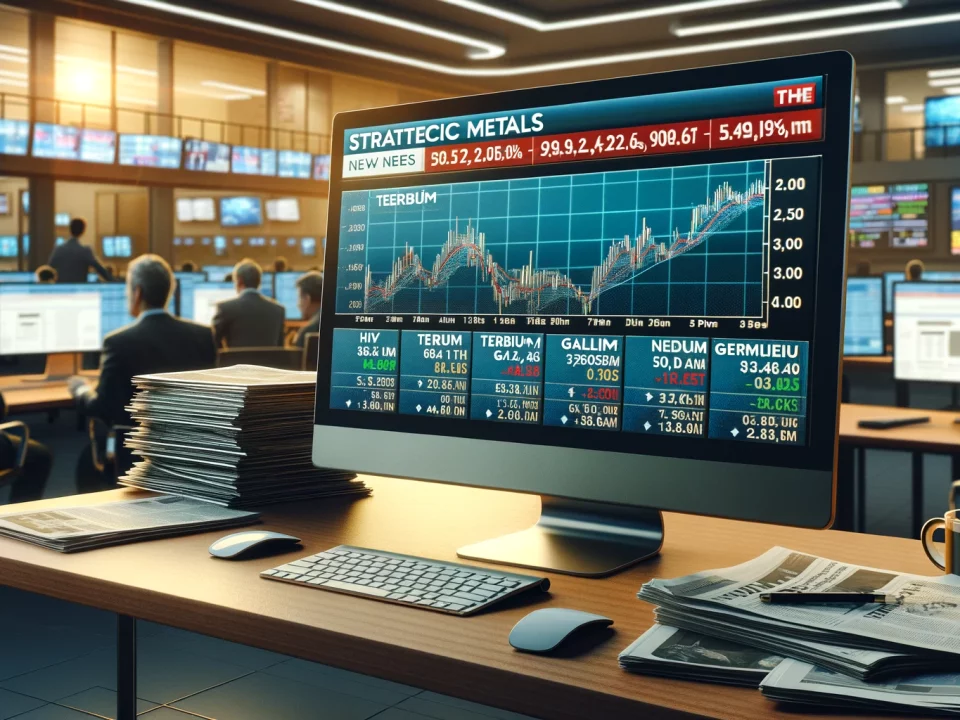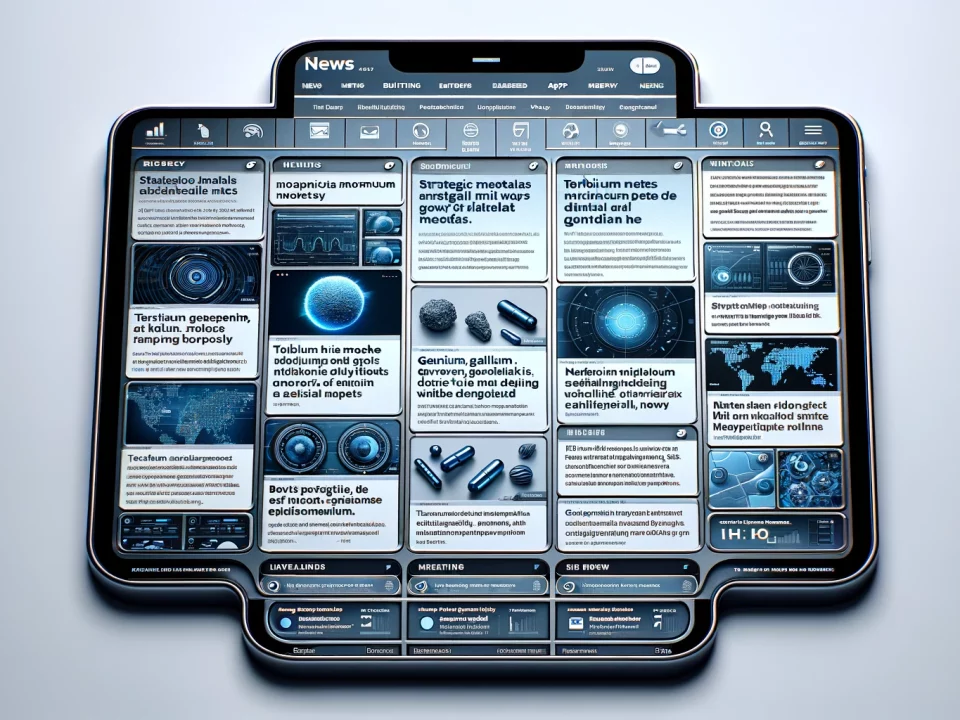
Weekly News Review July 28 – August 3 2025
August 3, 2025
Weekly News Review August 11 – August 17 2025
August 17, 2025This week, China’s July export data revealed a decline in rare earth shipments, while Europe’s wind industry called for stronger measures to reduce dependence on Chinese rare earth magnets. Meanwhile, U.S. rare earth miner MP Materials reported its latest quarterly results.
All this and more from the newsroom in our weekly round-up.
US DEPARTMENT OF DEFENCE INVESTS $10 MILLION TO BOOST DOMESTIC SCANDIUM PRODUCTION –
The U.S. Department of Defense (DoD) has awarded $10 million to Elk Creek Resources Corporation (ECRC), a wholly owned subsidiary of NioCorp Developments, to advance its Elk Creek scandium, niobium, and titanium project in Nebraska. The funding will support further exploration, engineering, and testing work.
Scandium alloys are becoming increasingly crucial in defense applications as well as in the aerospace industry due to their lightweight and high-strength characteristics. They are often used to replace titanium and aluminum alloys in military systems, Dr. Vic Ramdass, Acting Assistant Secretary of Defense for Industrial Base Policy, said.
Despite scandium’s growing relevance, nearly all global production currently comes from China, and the last recorded U.S. scandium mining activity occurred in 1969, according to the U.S. Geological Survey. In addition to scandium, the focus at Elk Creek also lies on ferroniobium and titanium dioxide production.
A June 2022 feasibility study estimated that Elk Creek could produce approximately 7,300 tons of ferroniobium per year as its primary product, along with 102 tons of scandium trioxide and 12,000 tons of titanium dioxide annually over its 38-year mine life. The company is also evaluating the potential to extract rare earth elements from the site, including neodymium-praseodymium oxide, dysprosium oxide, and terbium oxide.
This investment is part of the Department of Defense’s broader effort to strengthen domestic supply chains for critical minerals. In July, it awarded $6.2 million to a tungsten project in Nevada. In May, Perpetua Resources received $6.9 million for its antimony-gold project in Idaho.
AUSTRALIA: PRICE FLOORS TO BOOST INVESTMENT IN STRATEGIC METALS PROJECTS –
U.S. deal with MP Materials may set a precedent.
China dominates the extraction and production of many critical raw materials. This control gives it significant influence over global pricing, a challenge for Western industrial nations that depend heavily on these resources. The issue is not just high procurement costs; China can also artificially keep prices low, making it financially unfeasible for Western countries to develop their supply chains.
As a result, key stages of the value chain are largely absent in the West.
One potential solution is the introduction of government-guaranteed minimum prices. Australia’s Minister for Resources, Madeleine King, recently proposed this idea, including for rare earth elements. “Pricing certainty means companies and investors are less exposed to volatile markets and prices,” she told The Australian.
In July, the U.S. Department of Defense entered into a similar agreement with MP Materials, the country’s leading rare earth producer. As part of the deal, the Pentagon also became a significant shareholder in the company. According to a recent Reuters report citing insider sources, the U.S. government may pursue similar contracts with other raw materials companies.
EUROPE: WIND INDUSTRY AIMS TO CUT RELIANCE ON CHINA –
Permanent magnets made from rare earths are crucial components in wind turbines. They are essential in offshore installations, where they enable compact, robust, and low-maintenance generator systems; however, most of these high-tech parts and the raw materials needed to make them come from China. According to the EU, 98 percent of its demand for rare earth magnets is currently met through Chinese imports.
To reduce this dependency, Europe’s wind industry and Germany’s Federal Ministry for Economic Affairs and Energy (BMWi) have released a “resilience roadmap.” The plan outlines a goal of sourcing 30 percent of permanent magnets from alternative suppliers by 2030. By 2035, that share should rise to 50 percent. The plan also calls for at least 35 percent of rare earths to come from more resilient sources starting in 2030. Interim targets include securing supply agreements with alternative vendors by the end of 2026.
Boosting investment and coordinating demand:
To support this shift, the BMWi plans to back the industry through measures like funding for overseas investments and energy research. Partnerships with other countries are also on the table. A coordinated European purchasing mechanism for permanent magnets is being considered, along with financial support from the EU Innovation Fund. The roadmap also suggests creating a new price index to complement the existing one for Asian metals.
Whether these ambitious diversification targets can be met remains to be seen. So far, Japan is the only major producer of rare earth magnets outside China. While Japanese production is considered high quality, it accounts for only about 8 to 9 percent of the global market. Other countries, including the United States, Estonia, and South Korea, are still building up production capacities.
AUSTRALIA TO SOURCE RARE EARTH FEEDSTOCK FROM MALAWI:
Australian mining company Iluka Resources has entered into a long-term offtake agreement with Lindian Resources, developer of the Kangankunde rare earths project in Malawi. Under the deal, Lindian will supply 6,000 tons of monazite concentrate annually to Iluka over 15 years, representing approximately 10% of the refining capacity in its Eneabba facility once the plant becomes operational in 2027.
To support the development of Kangankunde, Iluka will also provide Lindian with a US$20 million (A$32 million) construction loan.
The monazite concentrate will be processed at Iluka’s Eneabba refinery, which is set to become Australia’s first fully integrated rare earths processing facility, capable of producing separated light and heavy rare earth oxides. Eneabba will use feedstock from Iluka’s internal operations as well as third-party suppliers like Lindian.
According to Lindian, the Kangankunde deposit contains 5.72 million tons of total rare earth oxides (TREO), of which 20.2 percent are neodymium and praseodymium. This positions Kangankunde among the most significant and highest-grade rare earth deposits globally. In April last year, the company received the final permit from the Malawi authorities to develop the project.
Lindian is not the only company advancing rare earth projects in Malawi. Canadian explorer Mkango Resources is also active in the country and last year signed a mining development agreement with the Malawian government.
USA: GM SIGNS SUPPLY DEAL WITH DOMESTIC MAGNET MANUFACTURER –
Rare earth elements are vital to the automotive industry, especially in the form of permanent magnets. While they are often discussed in the context of electric vehicles and their motors, magnets made of elements like neodymium also play a crucial role in conventional cars with internal combustion engines. They are used in a wide variety of applications, ranging from auxiliary motors in power windows to air conditioning systems.
U.S. automaker General Motors has now signed a supply agreement with Texas-based magnet manufacturer Noveon Magnetics to supply a product line of internal combustion engine vehicles. According to both companies, initial deliveries have already taken place in July. The partnership is part of a broader strategy to strengthen domestic supply chains.
China continues to dominate the global production of rare earths, and even more so, the manufacturing of permanent magnets derived from them. Noveon claims to be the only U.S. producer of sintered magnets made from neodymium-iron-boron alloy. This process involves compressing powdered materials under high pressure, sintering them at elevated temperatures into a solid form, and then magnetizing them.
To source the necessary raw materials, Noveon is tapping into emerging Western supply chains and supplementing them with recycled materials. General Motors, meanwhile, is actively pursuing partnerships outside of China, including one with German magnet manufacturer Vacuumschmelze.
CHINA: RARE EARTH EXPORTS DECLINE IN JULY –
After China set a record for rare earth exports in June 2025, shipments fell sharply in July, according to the latest data from customs authorities. At 5,994 tonnes, exports were down nearly 23 percent compared to last month. However, shipments still exceeded the average of the past twelve months.
In April, China imposed export controls on seven of the total seventeen rare earth elements. How these restrictions affected trade in the targeted materials in July will become clearer when detailed customs data is released in the coming weeks.
USA: MP MATERIALS EXPANDS PRODUCTION –
MP Materials, one of the leading U.S. producers of rare earth elements, reported a significant 84% year-over-year increase in revenue for the second quarter. According to the company, the growth was driven by higher production volumes of separated rare earths, as well as the first-time revenue contribution from precursor materials used in magnet manufacturing. Overall, output from the company’s Mountain Pass mine rose by 45%.
Despite the strong operational performance, the company still posted a net loss for the quarter, though it was smaller than analysts had anticipated, according to Reuters.
In July, the U.S. Department of Defense announced plans to invest $400 million in MP Materials. The two parties also signed a 10-year offtake agreement for neodymium-praseodymium (NdPr), featuring a price guarantee well above current market rates. The move was widely interpreted as a concrete step by the U.S. government toward building a supply chain independent of China.
Shortly after the Pentagon partnership was announced, MP Materials unveiled another strategic collaboration, this time with Apple. The tech giant will be sourcing magnets from MP Materials. According to CEO James Litinsky, the two companies have been working together on a technical level for the past five years.
Apple’s investment will help expand production capacity, and its global supply chain will make more recyclable materials available for reprocessing at MP Materials facilities, Litinsky noted during a conference call.
Figure of the Week: – 17.2 tons of newly mined raw materials and energy products are used by the average American each year.






